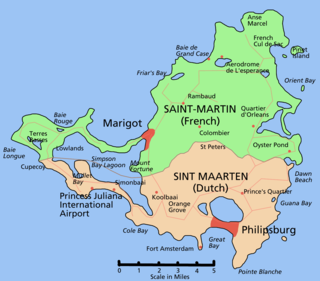
Hindu communities are found in several countries of South America, but they are strongest in Guyana and Suriname. There are about 550,000 Hindus in South America, chiefly the descendants of Indian indentured labourers in the Guianas. There are about 270,000 Hindus in Guyana, 150,000 in Suriname, and some others in French Guiana. In Guyana, Hindus form 35% of the population.
Indo-Caribbeans are Caribbean people with roots in the Indian subcontinent. They are mostly descendants of the original jahaji indentured workers brought by the British, the Dutch and the French during colonial times.

Indo-Trinidadians and Tobagonians or Indian-Trinidadians and Tobagonians, are nationals of Trinidad and Tobago whose ancestors came from South Asia.
Dougla is a word used by people especially in Trinidad and Tobago, Suriname and Guyana to describe people who are of mixed African and Indian descent.

2018 500,000. - 20.4%
Indo-Guyanese or Indian-Guyanese, are Guyanese nationals with heritage from South Asia. Most of the Indian indentured laborers who came to Guyana were from North India, specifically from the Bhojpur and Awadh regions in the Hindi Belt in the present-day states of Uttar Pradesh, Bihar, and Jharkhand. A significant minority of the indentured laborers care from South India, especially from places in present-day Tamil Nadu. Indo-Guyanese are the largest ethnic group in Guyana identified by the official census, making up 39.8% of the population in 2012. There is also a large Indo-Guyanese diaspora in countries such as the United States, Canada, and the United Kingdom.

The Tamil diaspora refers to descendants of the Tamil immigrants who emigrated from their native lands to other parts of the world. They are found primarily in Malaysia, Singapore, Myanmar, South Africa, Réunion, Mauritius, Europe, North America, and parts of the Caribbean, South America.

The Hindu community in France consists of some long-time residents and many recent immigrants. Although Hinduism does not constitute a large proportion of the population it appears to be growing rapidly; the current Hindu population of France is 121,312 or 0.2% of the nation's population, up from an estimated 50,000 in 1993.
Réunionnais of Indian origin are people of Indian origin in Réunion. They form two ethnic groups on the island, Malbars and Zarabes.
Indo-Seychellois are inhabitants of Seychelles with Indian heritage. With about 10,000 Indo-Seychellois in a total Seychellois population of 81,000, they constitute a minority ethnic group in Seychelles.
Indo-Grenadians or Grenadians who trace their roots to India, form the largest minority group in Grenada. This term is not generally recognized by Grenadians or indeed Caribbeans. They usually refer to themselves simply as Grenadian or possibly Caribbean. This group was first introduced during the second half of the 19th century when Grenada experimented with indentured labour. By the second half of the 20th century Indians were so integrated into Grenada’s society that a distinct Indian cultural identity was generally invisible. In addition, Indians were involved in every aspect of Grenadian life. Currently there are over 12,000 Grenadians of Indian and mixed-Indian descent.

Articles related to the French overseas department of Guadeloupe include:
Indians in French Guiana are mostly descendants of Tamil indentured labourers from India who live in the French Overseas Department of French Guiana.
Indo-Martiniquais are an ethnic group of Martinique, compromising approximately 10% of the population of the island. The Indo-Martiniquais are descendants of indentured laborers of the nineteenth century from India of primarily Tamil and of other Indian origin. They are primarily most concentrated in the northern communes of Martinique, where the main plantations are located. The Indo-Martiniquais speak Antillean a French-based creole.
The Pondichérien diaspora is a demographic group of people from Puducherry state of India who have emigrated and settled in other parts of the world, significantly in France, Réunion and the French Caribbean islands of Martinique and Guadeloupe. There are around 300,000 of them living around the world.

Hinduism is the second-largest religion in Suriname. According to the 2012 census of Suriname, Hindus constitute 22.3% of the population. Suriname has the second largest percentage of Hindus in the Western Hemisphere, after Guyana (24.8%).Suriname is also the only country in South America with an increasing Hindu population, both in percentage and absolute terms.

Hinduism is the religion of 24.8% of the population of Guyana. Guyana has the highest percentage of Hindus in the Western Hemisphere.

Hinduism is a minority religion in Guadeloupe, followed by some Indo-Guadeloupeans. According to a statistics data, Hinduism is practised by 0.5% of the people in Guadeloupe.















